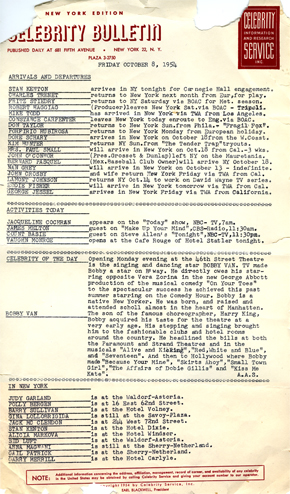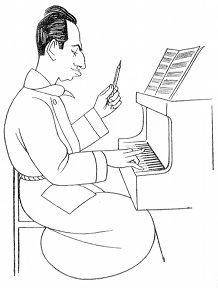Here are 10 things you should know about Cliff “Ukulele Ike” Edwards, born 127 years ago today. Edwards was a much bigger star in his heyday than many would guess today.
Tag: Ira Gershwin
Remembering Harold Arlen
The great songsmith Harold Arlen was born 116 years ago today in Buffalo, New York. His father was a Jewish cantor.
In the late 1920s and early ’30s, Arlen as a band vocalist with Red Nichols, Joe Venuti and Leo Reisman, among others.
Arlen wrote for motion pictures, Broadway musicals and Cotton Club reviews, working with such esteemed lyricists as Ted Koehler, E. Y. “Yip” Harburg, Ira Gershwin, and Johnny Mercer.
We’re featuring recordings of Arlen’s compositions all day today on Cladrite Radio. Why not tune in now?

10 Things You Should Know About Constance Cummings
Here are 10 things you should know about Constance Cummings, born 110 years ago today. An American, she spent nearly three-quarters of her life and career in the U.K.
Past Paper: Who’s Who and Who’s Where
A couple of years ago, Ms. Cladrite and I picked up a couple of bits of paper ephemera that caught our eye and piqued our interest.
We don’t really know much about these Celebrity Bulletins. They were published by a company called Celebrity Information and Research Service, Inc., which was located at 681 Fifth Avenue (at 54th Street) and could be reached by telephone at PLAZA 3-2750.
As you’ll see, we’ve shared both an international and a New York edition with you below. And apparently, if you were a subscriber to Celebrity Bulletin back in the day and you required “additional information concerning the address, affiliation, management, record of career, and availability of any celebrity in the United States,” you could obtain it by “calling Celebrity Service and giving your account number” to their operator.
By clicking on the New York edition below, you can learn that, on Friday, Ocober 8th, 1954, Count Basie was scheduled to appear on The Tonight Show with Steve Allen at 11:30 p.m. And that Eddie Fisher was due to arrive in NYC on Saturday, Oct. 9, via Trans-World Airlines from California.
Or, if you click on the International Edition, which carries a date stamp of September 14, 1954, you can learn that James Stewart, Preston Sturges, Yvonne De Carlo, and Ira Gershwin were all in Paris on that day, but no two of them were lodging at the same hotel.
Celebrity Service was co-founded with writer Ted Strong by one Earl Blackwell (not to be confused with bitchy fashion commentator Mr. Blackwell), whom the New York Times described in his 1995 obituary as “a society impresario who made his fortune keeping track of celebrities.”
“In 1939,” the Times continued, “[Blackwell] founded the lucrative New York-based Celebrity Service, an information and research service that has since opened branches in Hollywood, London, Paris and Rome. … Mr. Blackwell, who later bought his partner out, sold the business in 1985, but remained active as chairman until his death.”
Times Square Tintypes: George Gershwin
“STRIKE UP THE BAND”



